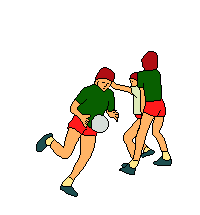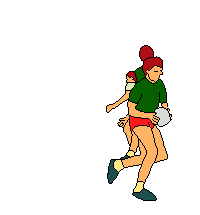Screenings are a tactically good attack weapon.
There are different
forms of screenings, and they can be used in many variations. If a trainer has
a little bit of fantasy, he can identify that or those screenings which suits
his players best, and then work with them in the training of the relevant exercises.
The most essential parts for a screening to succeed/be effective are:
| 1. | The intention can be hidden as long as possible in order that the opponent cannot perform a countermeasure. |
| 2. | It is timed/is precise i.e. the screening is performed/placed in the right moment when the shooter tries to bring herself in a good shooting position. |
| 3. | That the players if necessary have a certain start signal: passing, dribbling, eye contact, shout or something like that which means that now is the time to do the trained attack (running, screening, passing etc.) |
BUT REMEMBER: All screenings must be performed in accordance with the rules. They say:
| 1. | It is allowed with the body to block (screen) an opponent, whether she is in possession of the ball or not. |
| 2. | It is not allowed to block (screen) an opponent with arms, hands or legs. |
Below mention are some ways to perform a screening:
| 1. | Front screening - to block with your front to the player, who is to be screened. |
| 2. | Back screening - to block with your back to the player, who is to be screened. |
| 3. | Side screening - to block on the side with your front to the player, who is to be screened. |
| 4. | Side screening - to block on the side with your back to the player, who is to be screened. |
| 5. | Slant screening - to block slanted on the side with your back to the player, who is to be screened. |
| 6. | Slant screening - to block slanted on the side with your front to the player, who is to be screened (Russian). |
About screening exercises:
Some of the training
exercises are called basic exercises, i.e. exercises where the players change
position in the training circle (take turns being screener and shooter). However
there may also be 'blind' players, who act as defenders and team-mates.
These
basic exercises are especially for youth players, where all the players learns
de different screening forms based on the different playing positions. By this
they will have greater possibilities to use screening in situations independent
of their own place on the court.
In the other training exercises it is normal,
that the players do the exercises on their own place all the time. By this the
single player trains the special details in the collective game which she must
know, if the screening is to succeed in a playing situation in order to score.
The players may however sometimes change position in the training circles if
they want to try another place. The screening exercises are mostly shown for
right-handed players. For left-handed players the exercises can be trained laterally
reversed. Many of the exercises can be trained to both sides. It makes the players
more all-round and lesser dependent of their normal place.
Screenings
in game situations/finishing situations:
The examples
may show how a team in some fast finishing combinations where screening is used,
can bring themselves to a certain scoring chance.
The finishing game must
be varied dependent of the opponent's defense in such a way, that the team creates
some game situations where the finishing combinations will be natural.
The
finishing game can be performed freely from the basic play or can be trained
as a system.
It is important that the players know how to go on with the
play, if the defense makes a counter move or the scoring chance does not occur.
In several of the examples under the finishing game
 |
 |
 |
 |